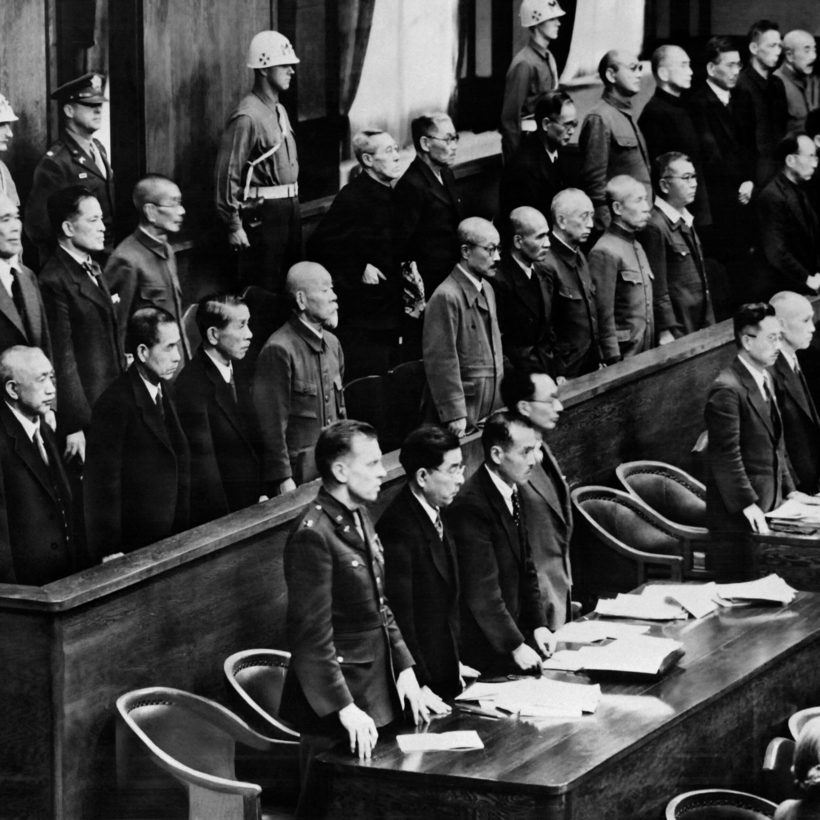Gary J. Bass begins his massive, magisterial account of the Tokyo War Crimes Trials with American military police arriving to arrest former Japanese prime minister Tojo Hideki at his home on September 11, 1945, a week after Japan formally surrendered to the Allies. During the war, especially in the early days after the Japanese surprise attack at Pearl Harbor, Tojo was widely regarded to be as wicked as Hitler. The Japanese war leader was grotesquely caricatured in American newspapers and magazines as an evil rodent.
As the soldiers burst into his home, Tojo shot himself with a pistol. He missed; the bullet only grazed his heart. Japanese and American doctors stitched him up and gave him blood in order to make him stand trial. “Pulling through,” writes Bass, Tojo “grew strong enough to lament that death was taking so long; he had meant to finish himself off with a single shot, he explained, rather than risking the delay of ritual disembowelment.” Tojo was condemned by the war-crimes trial and hanged three years later.

Bass uses Tojo’s botched suicide as a metaphor for his subject. “The Tokyo trial misfired and fizzled,” writes Bass. Most people know of the Nuremberg war-crime trials in Germany, widely regarded as a monument to international justice. The Tokyo war-crimes trials, not so much. In Judgment at Tokyo, Bass shows how good intentions can go awry.
This massive, magisterial account of the Tokyo War Crimes Trials begins with American military police arriving to arrest former Japanese prime minister Tojo Hideki at his home on September 11, 1945.
The inspiration for the war-crimes trials was a noble idea, that the nations of the world would come together to make “aggressive war” a crime—and, hopefully, a thing of the past. Such “one worldism” looks dreamy today, but it was an understandable response to the worst war in history.
Japan had a lot to answer for. Japanese soldiers and commanders who committed atrocities—torture, beheadings, even cannibalism—were dealt with (usually by hanging) at scores of war-crimes trials scattered around the Japanese-occupied areas, from the Philippines to Indonesia. Japan’s war leaders—so-called Class A war criminals—were tried in a huge, un-air-conditioned chamber in Tokyo that had been headquarters for the Japanese army. The trial dragged on for years and was hobbled by hypocrisy and incompetence by the judges and prosecutors.

Emperor Hirohito’s presence on the throne was necessary to keep the peace in occupied Japan, dictated the Supreme Commander of the Allied Powers, General Douglas MacArthur, so the emperor escaped trial. The 11 judges, representing Japan’s various enemies, were nearly all white. They came from British and Dutch empires, no strangers to harsh oppression. The Japanese complained of “victors’ justice.” Why, the Japanese asked, shouldn’t the Americans be held accountable for firebombing more than 60 Japanese cities? Or for killing more than 100,000 civilians by dropping atomic bombs on Hiroshima and Nagasaki?
Most people know of the Nuremberg war-crime trials in Germany, widely regarded as a monument to international justice. The Tokyo war-crimes trials, not so much.
In the end, all 25 Class A defendants were convicted of war crimes, and seven were sentenced to death by hanging. There was one blatant miscarriage of justice. Japanese foreign minister Togo Shigenori had vigorously tried to stop Japan from going to war against the U.S., in 1941, and he—almost alone among top officials—had persuaded the emperor to surrender, in 1945. He should have been exonerated; instead, he was sentenced to 20 years in prison, simply for being in the government.

Behind the scenes, the judges bickered and sulked, formed cliques and froze out dissenters. The chief judge, an Australian, was a bully; the chief prosecutor, an American, was a blustering fool. One judge—the only one with dark skin, Radhabinod Pal, of India—dismissed the whole proceeding as a trumped-up racist farce. Not surprisingly, he became a hero to the Japanese. “Today, Pal is honored at the Yasukuni war shrine, where visitors leave flowers at a monument to him in a prime location near the fiercely nationalist-themed museum,” writes Bass.
Bass delights in such twists. A longtime Princeton professor who once worked for The Economist magazine and whose 2013 book, The Blood Telegram (about Nixon-Kissinger misfeasance in Bangladesh), was a Pulitzer Prize finalist, Bass is a marvelous writer. He has a sharp, clear eye for telling detail. He may tell readers more than they care to know about the Tokyo war trials over the course of 692 pages, but the book, as he puts it, is history “in the round.” Readers will learn a great deal about a fascinating time that saw the collapse of Western empire in the Far East, the rise of Communist China, and the astonishing birth of a modern, peaceful, democratic Japan from the ashes of a war-mongering, semi-feudal society run by militarists with a death wish.
Some Allied leaders, including Winston Churchill, wanted drumhead justice for Japanese war criminals. Tojo was given a trial that lasted two and a half years. Shouting “Banzai!,” he was led to the gallows on December 23, 1948. A Buddhist priest assured Tojo that he would die instantly as his spinal cord was severed by the noose. His death took nine minutes.

Evan Thomas is the author of several books, including, most recently, Road to Surrender: Three Men and the Countdown to the End of World War II


